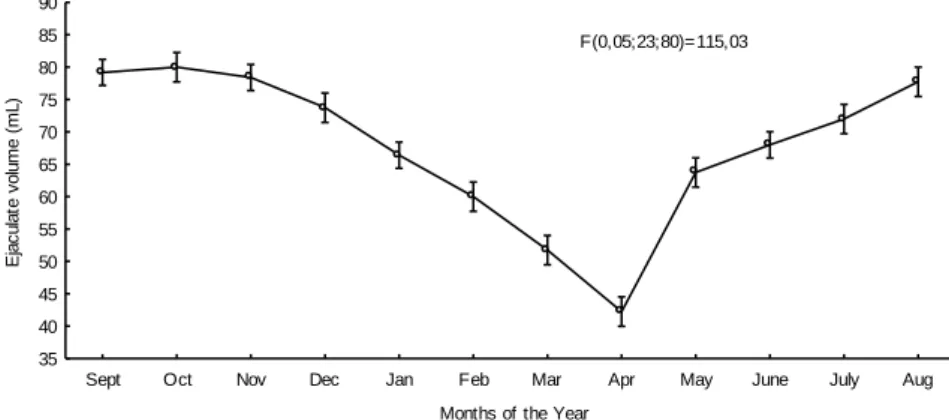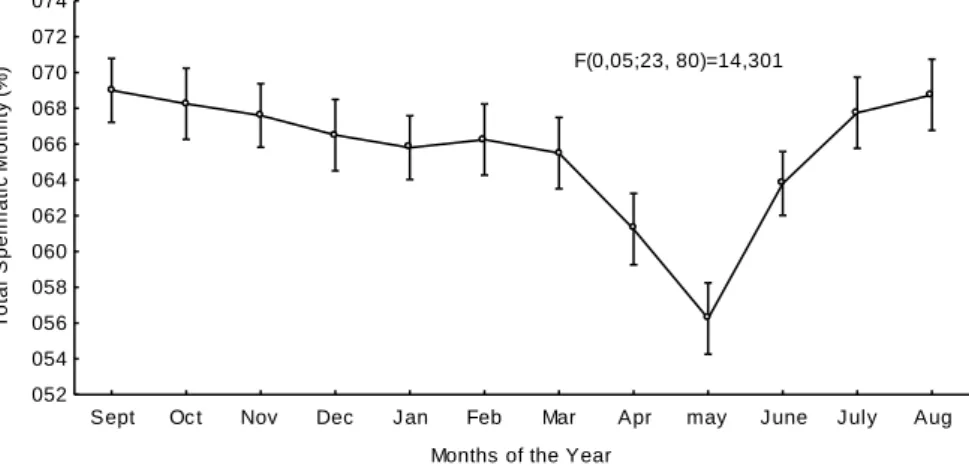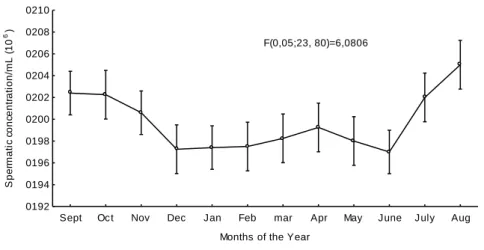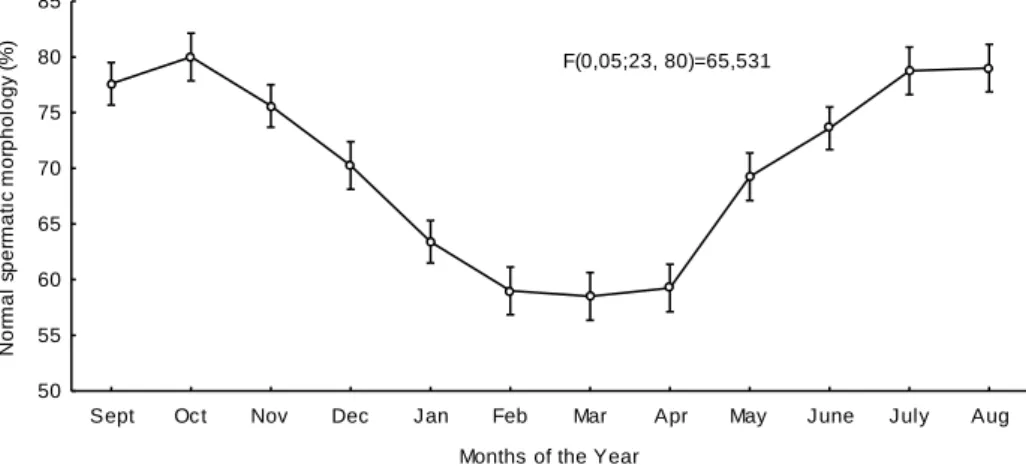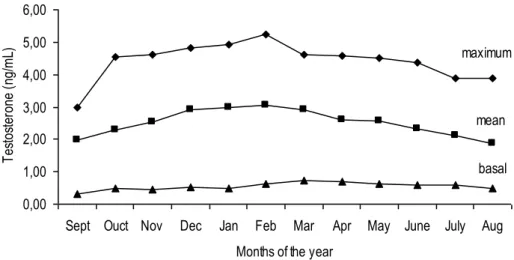Revista Científica Eletrônica de Medicina Veterinária é uma publicação semestral da Faculdade de Medicina veterinária e Zootecnia de Garça – FAMED/FAEF e Editora FAEF, mantidas pela Associação Cultural e Educacional de Garça ACEG. CEP: 17400-000 – Garça/SP – Tel.: (0**14) 3407-8000 www.revista.inf.br – www.editorafaef.com.br – www.faef.edu.br.
THE SEASON EFFECTS ON TESTOSTERONE (T4) AND SEMEN PARAMETERS OF QUARTER HORSE STALLIONS IN SOUTHERN BRAZIL
SANTOS, Ivo Walter
Universidade Federal do Paraná, Department of Veterinary Medicine, Palotina-PR, Brazil.
KOZICKI, Luiz Ernandes
Universidade Pontifícia Católica do Paraná, Professor of the Master of Animal Science, Curitiba-PR, Brazil.
WEISS, Romildo Romualdo
Universidade Federal do Paraná, Department of Veterinary Medicine, Curitiba-PR, Brazil.
FERRAZ, Alana Mayara
Universidade Federal do Paraná, Department of Veterinary Medicine, Palotina-PR, Brazil.
CEMENCI, Mariana Rossoni
Universidade Federal do Paraná, Department of Veterinary Medicine, Palotina-PR, Brazil.
BINSFELD, Luiz Carlos
Universidade Federal do Paraná, Department of Veterinary Medicine, Palotina-PR, Brazil. iwalterdossantos@yahoo.com.br or santosiw@ufpr.br
Revista Científica Eletrônica de Medicina Veterinária é uma publicação semestral da Faculdade de Medicina veterinária e Zootecnia de Garça – FAMED/FAEF e Editora FAEF, mantidas pela Associação Cultural e Educacional de Garça ACEG. CEP: 17400-000 – Garça/SP – Tel.: (0**14) 3407-8000 www.revista.inf.br – www.editorafaef.com.br – www.faef.edu.br.
SUMMARY
The aim of this study was to evaluate some profiles of semen and total testosterone (T4) of stallions quarter Horse in stud-farm situated in Southern Brazil, during the 2008/2009 breeding season (September, October, November, December, January and February), and compare them with the months outside the breeding season (March-August 2009). 52 semen samples were collected from each animal, once a week. The semen was collected by colorado model artificial vagina method, the volume of ejaculate free gel, total motility, concentration, and spermatic morphology were evaluated. Once a month, the blood was collected by jugular venipuncture at 00:00, at 4:00, at 8:00, at 12:00, at 16:00 and at 20:00 hours, to determine the serum T4. The parameters of seminal
volume, sperm concentration and morphology were significantly correlated in the months of the breeding season, compared to non-breeding season. The highest amplitude testosterone (ng/mL) was detected in February (3,06±1,49) compared to the months of September, October, November, April, May, June, July and August. During daylight hours, the highest peak testosterone (ng/mL) was detected at 8:00 h (F=202,79) compared to the other times. It was concluded that outside the breeding season, the spermatic parameters from Quarter Horse stallions, in southern Brazil, are compatible to the parameters of equine fertility.
Key words: Breeding season, Equine, Seasonality, Semen, Testosterone,
INTRODUCTION
Studies with different stallion breeds show that the testicle dimensions and the season did not influence the semen quality parameters; however, they altered the ejaculated volume (BLANCHARD et al., 2001; LOVE, 2002; HENINGER et al., 2004; MAXWELL; JOHNSON, 2000 and VIDAMENT et al. 2006).
There is a European research which demonstrated that the spermatic abnormalities were reduced during the breeding season (Van der HOLST, 1975).
Revista Científica Eletrônica de Medicina Veterinária é uma publicação semestral da Faculdade de Medicina veterinária e Zootecnia de Garça – FAMED/FAEF e Editora FAEF, mantidas pela Associação Cultural e Educacional de Garça ACEG. CEP: 17400-000 – Garça/SP – Tel.: (0**14) 3407-8000 www.revista.inf.br – www.editorafaef.com.br – www.faef.edu.br.
Although there are evidences that stallions spermatic production decreases out of the breeding season (BIELANSKI et al.,1982; BRITO, 2007). WRENCH et al.(2010), in a recent study did not discover differences between the breeding and the non-breeding season regarding to the ejaculated volume, the concentration, the total number of movable spermatozoon or the progressive motility of the ejaculated by stallions. ROBALO SILVA et al. (2007), evaluating some reproductive parameters related to the sexual behavior of equines in the North hemisphere, observed that the stud horses presented themselves less efficient in the fall and winter than in the spring and summer. The spermatozoon concentration and the percentage of living spermatozoon, with progressive motility and normal morphology, were identical throughout the seasons. The average total volume of the ejaculated progressively decreased from spring to winter CAZALES et al.(2008). NASCIMENTO et al. (2008) evaluated the volume, the concentration, the motility and the vigor of the spermatozoon: the average of the volume of 77,2 mL, the concentration of 143,5 x106sptz./mL, the motility of 76,1%, and the vigor of 2,6. Fertility analyses showed that the minimum limit of 1,8 x 109 viable spermatozoon, 50% of motility, and 60% of morphologically normal spermatozoon in the ejaculated are critical to the quality of the ejaculated, being the morphology the essential factor (FERNANDES and PIMENTEL, 2002). The progressive spermatozoon motility of 14,2% and the medium value of total motility of 70%. (TERRACIANO et al.2008).
Reports from the literature indicate clearly that testosterone is essential for the maintenance and the restoring of the spermatogenesis in the testicles of adult equines (MATSUMOTO, 1989; WEINBAUER and NIESCHLAG, 1993).
The objective of the present research was to evaluate some profiles of semen and the total testosterone of Quarter Horse stallions, during the breeding season of 2008/2009 (in the months of September, October, November, December, January and February), and to compare them with the months out of the breeding season (from March to August of 2009) and to know if the semen of stallion Quarter Horse show minimal fertility to be used in breeding programs in non-breeding season.
Revista Científica Eletrônica de Medicina Veterinária é uma publicação semestral da Faculdade de Medicina veterinária e Zootecnia de Garça – FAMED/FAEF e Editora FAEF, mantidas pela Associação Cultural e Educacional de Garça ACEG. CEP: 17400-000 – Garça/SP – Tel.: (0**14) 3407-8000 www.revista.inf.br – www.editorafaef.com.br – www.faef.edu.br.
MATERIAL AND METHODS
Eight Quarter Horse stallions with proved fertility, from 6 to 13 years old, what follows the requisites of the manual to andrology examination and animal semen evaluation from the Brazilian Academy of Animal Reproduction (CBRA,1998).
The stallions were used to sport and remained in individual paddocks with grazing tifton 85 (Cynodon spp), water and mineral salt ad libitum. In the morning they received 2 kilograms of a mixture of corn and oats medium / medium and night 2 kilograms of alfalfa hay (Medicago sativa).
The ranches are located in the city of Palotina, Parana state, Southern Brazil, latitude -24 ° 17 '02"S, longitude -53 ° 50' 24"W, altitude 310 meters, average temperatures maximum = 28,7°C and minimum = 16,0°C from Parana Agronomic Institute (IAPAR, 2010).
The samples of semen were collected regularly at 18:00 hours, through the artificial vagina method, Colorado model, once a week, a total of 52 sample collections per animal were conducted, from September 2008 to February 2009 (breeding season in the South hemisphere) and from March to August 2009 (non-breeding season).
During these periods blood samples through jugular venipuncture were collected, once a month at 00:00, 04:00, 08:00, 12:00, 16:00 e 20:00 hours according to what SHARMA (1976) described, a total of 72 sample collections per animal were conducted.
After blood coagulation, 3 mL of serum were collected and stored at -20 °C to later dosing of total (T4) testosterone through chemiluminescence [Roche Diagnostics, Mannheim, Germany apply the platform Automated Modular E170, Reference 05200067 190, sensitivity 2.56 ng/mL (8.88 nmol/L), Coefficients of variation intra-assay 2.6% and inter-intra-assay 3.6% ] at Laboratório Álvaro, Cascavel, Paraná state, Brazil. After semen collection, the gel fraction was rejected, and the semen was filtered in sterile gauze. The volume of the ejaculate free from the gel, the total (MT) motility, the concentration, the spermatic morphology were evaluated using a microscope with phase contrast in 200x (Olympus BX41TF, Tokyo, Japan) as described by Kennedy et al. (1983). The spermatic concentration was made in the Neubauer chamber from one semen sample without gel, diluted in the proportion of 1:20, and preserved in saline
Revista Científica Eletrônica de Medicina Veterinária é uma publicação semestral da Faculdade de Medicina veterinária e Zootecnia de Garça – FAMED/FAEF e Editora FAEF, mantidas pela Associação Cultural e Educacional de Garça ACEG. CEP: 17400-000 – Garça/SP – Tel.: (0**14) 3407-8000 www.revista.inf.br – www.editorafaef.com.br – www.faef.edu.br.
formaldehyde solution 1% (HANCOCH, 1957). The total of ejaculated spermatozoon was calculated based on the multiplication of the concentration (x106/mL) and the volume of the semen without gel. The spermatic morphology was evaluated through humid preparation (contrast of phase) proceeding from samples maintained in buffered saline formaldehyde solution 1%.
The analysis of variance was used to compare the variables: volume of the ejaculated, concentration, total of ejaculated spermatozoon, total motility and spermatic morphology among the months of the year and serum levels of T4 related at the times of the day. The post hoc comparisons were made using Tukey’s test. The serum levels of T4 related to the months of the year were analyzed through means and standard deviation. Statistical significance was defined as P < 0,05.
RESULTS
The semen parameters in and out of the breeding season are presented below: The Figure 1 show the volume of the ejaculate was higher (F=115,03) in the breeding season in the months of October and November in comparison to the non-breeding season, in the months of March and April.
Sept Oct Nov Dec Jan Feb Mar Apr May June July Aug Months of the Year
35 40 45 50 55 60 65 70 75 80 85 90 E ja c u la te v o lu m e ( m L ) F(0,05;23;80)=115,03
Figure 1. Ejaculate volume from Quarter Horse stallions during 12 months, in the months of the breeding season and out of them (2008/2009), in stud farms in Southern Brazil.
Revista Científica Eletrônica de Medicina Veterinária é uma publicação semestral da Faculdade de Medicina veterinária e Zootecnia de Garça – FAMED/FAEF e Editora FAEF, mantidas pela Associação Cultural e Educacional de Garça ACEG. CEP: 17400-000 – Garça/SP – Tel.: (0**14) 3407-8000 www.revista.inf.br – www.editorafaef.com.br – www.faef.edu.br.
In relation to the spermatic motility (Figure 2) differences between the breeding and non-breeding season were observed, however, in the months of September and October there were the best improvements (F=14,301) and the worst impairments in the April and May.
Sept Oc t Nov Dec J an Feb Mar Apr may J une J uly Aug
Months of the Year 052 054 056 058 060 062 064 066 068 070 072 074 T o ta l S p e rm a ti c M o ti li ty ( %) F(0,05;23, 80)=14,301
Figure 2. Spermatic total motility from Quarter Horse stallions during 12 months, in the months of the breeding season and out of them (2008/2009), in stud farms in Southern Brazil.
About the spermatic concentration variable (Figure 3), it was observed that in the September and October, July and August were better (F=6,0806) than the others months of the season breeding and non-breeding season respectively.
Revista Científica Eletrônica de Medicina Veterinária é uma publicação semestral da Faculdade de Medicina veterinária e Zootecnia de Garça – FAMED/FAEF e Editora FAEF, mantidas pela Associação Cultural e Educacional de Garça ACEG. CEP: 17400-000 – Garça/SP – Tel.: (0**14) 3407-8000 www.revista.inf.br – www.editorafaef.com.br – www.faef.edu.br.
Sept Oct Nov Dec Jan Feb mar Apr May June July Aug
Months of the Year 0192 0194 0196 0198 0200 0202 0204 0206 0208 0210 S p e rm a ti c co n ce n tr a ti o n /m L ( 1 0 6 ) F(0,05;23, 80)=6,0806 .
Figure 3. Spermatic concentration from Quarter Horse stallions during 12 months, in the months of the breeding season and out of them (2008/2009), in stud farms in Southern Brazil.
The total spermatozoa in ejaculated was higher (F=114,02) in the breeding season in the months of October and November in comparison to the non-breeding season, in the months of March and April (Figure 4).
Sept Oct Nov Dec Jan Feb Mar Apr May June July Aug
Months of the Year 7000 8000 9000 10000 11000 12000 13000 14000 15000 16000 17000 18000 T o ta l sp e rm i n e ja cu la te d ( 1 0 6 ) F(0,05;23, 80)=114,02
Revista Científica Eletrônica de Medicina Veterinária é uma publicação semestral da Faculdade de Medicina veterinária e Zootecnia de Garça – FAMED/FAEF e Editora FAEF, mantidas pela Associação Cultural e Educacional de Garça ACEG. CEP: 17400-000 – Garça/SP – Tel.: (0**14) 3407-8000 www.revista.inf.br – www.editorafaef.com.br – www.faef.edu.br.
Figure 4. Total sperm in ejaculated from Quarter Horse stallions during 12 months, in the months of the breeding season and out of them (2008/2009), in stud farms in Southern Brazil.
About the spermatic morphology, the perceptual of normal spermatozoon was better (F=65,531) in the months of October, July and August when compared with the others months of the season breeding and non-breeding season respectively (Figure 4).
Sept Oct Nov Dec Jan Feb Mar Apr May June July Aug
Months of the Year 50 55 60 65 70 75 80 85 N o rm a l sp e rm a ti c m o rp h o lo g y (% ) F(0,05;23, 80)=65,531
Figure 5. Normal spermatic morphology from Quarter Horse stallions during 12 months, in the months of the breeding season and out of them (2008/2009), in stud farms in Southern Brazil.
The stallions’ serum T4 levels can be observed in figures 6 and 7. Figure 6 shows the basal, mean and maximum variations of the total serum T4 levels during the 12 months. The highest peak of T4 (ng/mL) was detected in the month of February (3,06±1,49) in relation to the months of September, October, November, April, May, June, July and August. Among the months of December, January, February and March there was no difference. The basal and mean levels there were no difference among the months.
Revista Científica Eletrônica de Medicina Veterinária é uma publicação semestral da Faculdade de Medicina veterinária e Zootecnia de Garça – FAMED/FAEF e Editora FAEF, mantidas pela Associação Cultural e Educacional de Garça ACEG. CEP: 17400-000 – Garça/SP – Tel.: (0**14) 3407-8000 www.revista.inf.br – www.editorafaef.com.br – www.faef.edu.br.
0,00 1,00 2,00 3,00 4,00 5,00 6,00
Sept Ouct Nov Dec Jan Feb Mar Apr May June July Aug
Months of the year
Te sto ste ro ne (n g/m L) basal mean maximum
Figure 6: Serum testosterone amplitude determined by chemiluminescence obtained from Quarter Horse stallions during 12 months, in the months of the breeding season and out of them (2008/2009), in stud farms in Southern Brazil.
In figure 7 the means variations of the serum testosterone pulses during the 24 hours of the day are shown. The highest pulse (ng/mL) was detected at 8:00 h (F=202,79) in relation to the other times of the day however, there was no significant difference between 4:00 and 12:00 h. These data were not statistically different in and out of the breeding season.
0:00 4:00 8:00 12:00 16:00 20:00
T imes of the day 0,0 0,5 1,0 1,5 2,0 2,5 3,0 3,5 4,0 4,5 5,0 T e st o st e ro n e ( n g /m L ) F(0,05; 5,564)=202,79
Revista Científica Eletrônica de Medicina Veterinária é uma publicação semestral da Faculdade de Medicina veterinária e Zootecnia de Garça – FAMED/FAEF e Editora FAEF, mantidas pela Associação Cultural e Educacional de Garça ACEG. CEP: 17400-000 – Garça/SP – Tel.: (0**14) 3407-8000 www.revista.inf.br – www.editorafaef.com.br – www.faef.edu.br.
Figure 7 Serum testosterone pulses determined at 00:00, 4:00, 8:00, 12:00, 16:00 e 20:00 h, through chemiluminescence, obtained from Quarter Horse stallions, in and out of the months of the breeding season (2008/2009), in stud farms in Southern Brazil.
DISCUSSION
In relation to the volume of the ejaculate and total sperm in ejaculate reach its peak in October, then declined until March, then, was improving by the month of August end of the non-breeding season (Figures 1 and 4). Comparing the volume of the ejaculated between the two seasons, it was observed that in the breeding season the averages were higher than the ones obtained out of the season. These data corroborate the statements made by BLANCHARD et al. (2001), LOVE, 2002; ROBALO SILVA et al. (2007) and CAZALES et al. (2008), who observed in their experiments the difference mentioned before.
Analyzing Figure 2, we observe that during the breeding season to total sperm motility was stable. Thus, in non-reproductive season there is a decline, reaching its worst performance in the month of May (F=14,301).Comparing the data about the semen motility, differences between the breeding and non-breeding season were not observed, these data are in accordance with the reports of several researchers as BLANCHARD et al. 2001; VIDAMENT et al. (2006); ROBALO SILVA et al. (2007) and WRENCH et al. (2010).
The spermatic concentration was better (6,0806) (Figure 3) when the semen was collected in September and October at the beginning of the breeding season, July and August at the end of non-breeding season, which is compatible to the results described by FERNANDES and PIMENTEL (2002) and HENINGER et al. (2004).
It was observed that the normal spermatic morphology had his best performance in October, July and August and the worst in the months of February, March and April corroborating the results of FERNANDES and PIMENTEL (2002).
The data signalize that the stallion’s spermatogenesis showed itself more effective during the breeding season, it is confirmed by the percentage of normal spermatozoon, which was superior in relation to the one in the non-breeding season,
Revista Científica Eletrônica de Medicina Veterinária é uma publicação semestral da Faculdade de Medicina veterinária e Zootecnia de Garça – FAMED/FAEF e Editora FAEF, mantidas pela Associação Cultural e Educacional de Garça ACEG. CEP: 17400-000 – Garça/SP – Tel.: (0**14) 3407-8000 www.revista.inf.br – www.editorafaef.com.br – www.faef.edu.br.
reported by MAXWELL and JOHNSON (2000) and ROBALO SILVA et al. (2007), even though, BRITO et al., 2007 reported that the results are still controversial, thus more studies are necessary.
Analyzing the pulse amplitude of T4during the months of the year in and out of the breeding season (Figure 6) it can be observed that T4 reached the highest amplitude in February (3,061,49) in relation to the other months of the year, which showed similar amplitude from each other. The Figure 7 show that the number of pulses of the T4 measurements. It was verified that the highest peak occurred at 8:00 h and the lowest peak at 20:00 (F=202,79). The findings related to the serum levels of the total T4agree with the reports from SHARMA (1976), however VIDAMENT et al.(2006) concluded that the levels of T4 and other seminal parameters were not affected when in or out of the breeding season. In this sense BRITO et al. (2007), enhance with propriety that the differences between the equine breeding and non-breeding seasons may consist on differences of photoperiod, stress from heat or even though of food quality, these differences may enable endocrine changes related inclusively to the T4.
The stallions’ time of pre-coital was not measured in this study, and it was not observed disinterest in the mannequin (restrained mare), during the collections using artificial vagina, from any of the stallions.
CONCLUSION
This research concluded that out of the breeding season, the seminal parameters proceeding from Quarter Horse stallions, in Southern Brazil, are similar to the fertility parameters described by CBRA (1998). This indicates that in southern Brazil, the equine semen can be used in breeding programs in biotechnology out-of- season.
The seminal parameters, as well as free T4 levels determined in the breeding season were superior to the parameters when out of the breeding season, it signalizes that the androgen levels are important for the spermatogenesis maintenance in adult testicles of equines, which confirms the reports by MATSUMOTO, (1989), WEINBAUER and NIESCHLAG (1993).
Revista Científica Eletrônica de Medicina Veterinária é uma publicação semestral da Faculdade de Medicina veterinária e Zootecnia de Garça – FAMED/FAEF e Editora FAEF, mantidas pela Associação Cultural e Educacional de Garça ACEG. CEP: 17400-000 – Garça/SP – Tel.: (0**14) 3407-8000 www.revista.inf.br – www.editorafaef.com.br – www.faef.edu.br.
REFERENCES
BIELANSKI, W.; DUDEK, E.; BITTMAR, A. et al. Some characteristics of common abnormal forms of spermatozoa in highly fertile stallions. Journal of Reproduction and Fertility, v.32,p.21-26, 1982.
BLANCHARD, T.L; JOHNSON, L; BRINSKO, S.P. et al. Evaluation of testicular size and function in 1-3-year-old stallions, in Proceedings. Annual conv. AAEP 2001, v.47, p.232-235
BLOTTNER, S.; WARNKE,C.; TUCHSCHERER, A. et al. Morphological and functional changes of stallion spermatozoa after cryopreservation during breeding and non-breeding season. Animal reproduction Science, v. 65, p.75-88,2001.
BRITO, L.F.C. Evaluation of stallion sperm morphology. Clinical Techniques in Equine Practice, v.6,p.249-264,2007.
CAZALES, N.; ELHORDOY, D.; COSTA, G. et al. Seasonal variations in equine seminal parameters in Uruguay – Preliminary results. Animal Reproduction Science, v.107, p.315, 2008.
COLÉGIO BRASILEIRO DE REPRODUÇÃO ANIMAL - CBRA. Manual para exame andrológico e avaliação de sêmen animal. 2 ed., MA/CBRA nº 021/1997, Belo Horizonte, 1998, 49p.
FERNANDES, C.E; PIMENTEL, C.A. Características seminais e fertilidade em garanhões, Ciência Rural, v. 32, n.5, p. 829-834, 2002.
HANCOCK, J.L. The morphology of boar spermatozoa. Journal of the Microscopic Society, v. 76, p. 84-97, 1957.
Revista Científica Eletrônica de Medicina Veterinária é uma publicação semestral da Faculdade de Medicina veterinária e Zootecnia de Garça – FAMED/FAEF e Editora FAEF, mantidas pela Associação Cultural e Educacional de Garça ACEG. CEP: 17400-000 – Garça/SP – Tel.: (0**14) 3407-8000 www.revista.inf.br – www.editorafaef.com.br – www.faef.edu.br.
HENINGER, N.L.; STAUB, C.; BLANCHARD, T.L. et al. Germ cell apoptosis in the testis of normal stallions. Theriogenology, v.62, p.283-297, 2004.
KENNEDY, R.M.; HURTGEN, J.P.; PEARSON, R. et al. Society for theriogenology: manual for clinical fertility evaluation of the stallion. Hastings, NB: NY, 1983, 100 p.
LOVE, C. Stallion semen evaluation and interpretation. Proceedings Society for Theriogenology, p.93-102, 2002.
MATSUMOTO, A. Hormonal control of spermatogenesis. In : Burger,H.;Kretser,D. The testis. 2 ed. Raven Press., New York, p.181-196, 1989.
MAXWELL, W.M.C.; JOHNSON, L.A. Physiology of spermatozoa of a dilution rates: the influence of seminal plasma. Theriogenology, v.52, p.1273-1280, 2000.
NASCIMENTO, J.; RAPHAEL, C. F.; ANDRADE, A. F. et al. Effects of Sperm Concentration and Straw Volume on Motion Characteristics and Plasma, Acrosomal, and Mitochondrial Membranes of Equine Cryopreserved Spermatozoa. Journal of Equine Veterinary Science, v. 28, p. 351-358, 2008.
PARANA AGRONOMIC INSTITUE – IAPAR. Technical bulletin, 2010, available at: http:/www.iapar.br/arquivos/image/monitoramento/medias/-historicas/palotina.htm. Accessed at: March 10, 2011.
ROBALO SILVA, J.; AGRÍCOLA, J.; BARBOSA, M. et al. Variação sazonal do volume testicular, da produção e qualidade do sêmen e do comportamento sexual de cavalos Lusitanos, Revista Portuguesa de Ciências Veterinárias, v.102, n. 561, p. 119-125, 2007.
Revista Científica Eletrônica de Medicina Veterinária é uma publicação semestral da Faculdade de Medicina veterinária e Zootecnia de Garça – FAMED/FAEF e Editora FAEF, mantidas pela Associação Cultural e Educacional de Garça ACEG. CEP: 17400-000 – Garça/SP – Tel.: (0**14) 3407-8000 www.revista.inf.br – www.editorafaef.com.br – www.faef.edu.br.
SHARMA, O.P. Diurnal variations of plasma testosterone in stallions. Biology of Reproduction, v. 15, p.158-162, 1976.
TERRACIANO, P.B.; BUSTAMENTE-FILHO, I.C.; MIQUELITO, L.V. et al.
Criopreservação de espermatozóides eqüinos comparando duas curvas de congelamento combinadas com diluentes comerciais: uma análise laboratorial, Ciência Rural, v.38, n.7, p.1972-1977, 2008.
VAN DER HOLST,W. A study of the morphology of stallion semen during the breeding and non-breeding seasons. Journal of Reproduction and Fertility (suppl), p.87-89,1975.
VIDAMENT, M.; LARRY,J.L.; ARNAUD, G. et al. Effect of stabling stallions with mares during the non-breeding season on semen collection behaviour, semen
characteristics and plasma testosterone concentrations. Animal Reproduction Science, v.94,p.50-53, 2006.
WEINBAUER, G.F.; NIESCHLAG, E. Hormonal control of spermatogenesis. In: Kretser,D. Molecular Biology of male reproductive system. Academic press, New York, p. 99-142, 1993.
WRENCH, N.; PINTO,C.R.F.; KLINIFELTER,G.R. et al. Effect of season on fresh and cryopreserved stallion semen. Animal Reproduction Science,v.119,p.219-227,2010.
